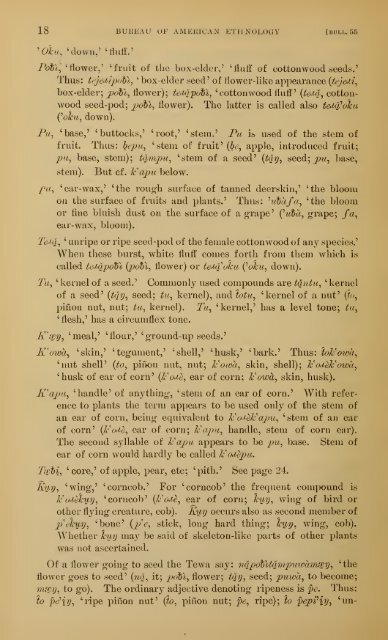Untitled - Smithsonian Institution
Untitled - Smithsonian Institution
Untitled - Smithsonian Institution
You also want an ePaper? Increase the reach of your titles
YUMPU automatically turns print PDFs into web optimized ePapers that Google loves.
18 BUREAU OF AMERICAN ETHNOLOGY [bull. 55<br />
'Ohi, 'down,' 'Huff.'<br />
Pdb\^ 'flower,' 'fruit of the box-elder,' 'fluff of cottonwood seeds.'<br />
Thus: teje^iiptJb^b, ' box-elder seed ' of flower-like appearance {tejedi^<br />
box-elder; 2>db\ flower); tedq'poWi^ ' cotton wood flufi'' {teM^ cottonwood<br />
seed-pod; poVi^ flower). The latter is called also te^iiCoku<br />
i^oku, down).<br />
Pu., 'base,' 'buttocks,' 'root,' 'stem.' Pu is used of the stem of<br />
fruit. Thus: hepu., 'stem of fruit' (Sc, apple, introduced fruit;<br />
pu^ base, stem); tmnpu, 'stem of a seed' {tay, seed; ^i^, base,<br />
stem). But cf. ¥apu below.<br />
/"«, 'ear-wax,' 'the rough surface of tanned deerskin,' 'the bloom<br />
on the surface of fruits and plants.' Thus: ^uMfa, 'the bloom<br />
or fine bluish dust on the surface of a grape' Cuba, grape; /a,<br />
ear-wax, bloom).<br />
Te^Q, ' unripe or ripe seed-pod of the female cottonwood of any species.'<br />
When these burst, white fluff' comes forth from them which is<br />
called tMQpobl {pdb\ flower) or te^i^oku (^oku, down).<br />
Tu, 'kernel of a seed.' Commonly used compounds are tq.ntu, 'kernel<br />
of a seed' {tqrj, seed; tu, kernel), and foz!i^, 'kernel of a nut' (^<br />
pinon nut, nut; tu^ kernel). Tu, 'kernel,' has a level tone; tu,<br />
'flesh,' has a circumflex tone.<br />
K^s^y, 'meal,' 'flour,' 'ground-up seeds.'<br />
K'owa, 'skin,' 'tegument,' 'shell,' 'husk,' 'bark.' Thus: ioFoim,<br />
'nut shell' {to, pifion nut, nut; Fotva, skin, shell); Fo^ieFowa,<br />
'husk of ear of corn' {¥ode, ear of corn; ¥owa, skin, husk).<br />
K^apu, 'handle' of anything, 'stem of an ear of corn.' With reference<br />
to plants the term appears to be used only of the stem of<br />
an ear of corn, being equivalent to h\ue¥apu, 'stem of an ear<br />
of corn' {Ji'o'ie, ear of corn; k'apni, handle, stem of corn ear).<br />
The second syllable of k'apic appears to be pu, base. Stem of<br />
ear of corn would hardly be called Vod,epu.<br />
Tseii, 'core,' of apple, pear, etc; 'pith.' See page 24.<br />
Kii7j, 'wing,' 'corncob.' For 'corncob' the frequent compound is<br />
h'iUekyjT), 'corncob' {¥o>ie, ear of corn; Iciirj, wing of bird or<br />
other flying creature, cob). Kilt) occurs also as second member of<br />
jpek^'T), 'bone' {p^e, stick, long hard thing; Ic^y, wing, cob).<br />
Whether hiin) may be said of skeleton-like parts of other plants<br />
was not ascertained.<br />
Of a flower going to seed the Tewa say: TiQpdbltq.mpuwamsRy, 'the<br />
flower goes to seed' (/ig, it; ^wSl, flower; tqy, seed; puwa, to become;<br />
msRy, to go). The ordinary adjective denoting ripeness is pe. Thus:<br />
to pe'iy, 'ripe pinon nut' {to, piiion nut; pe, ripe); to pepi^iy, 'un-

















